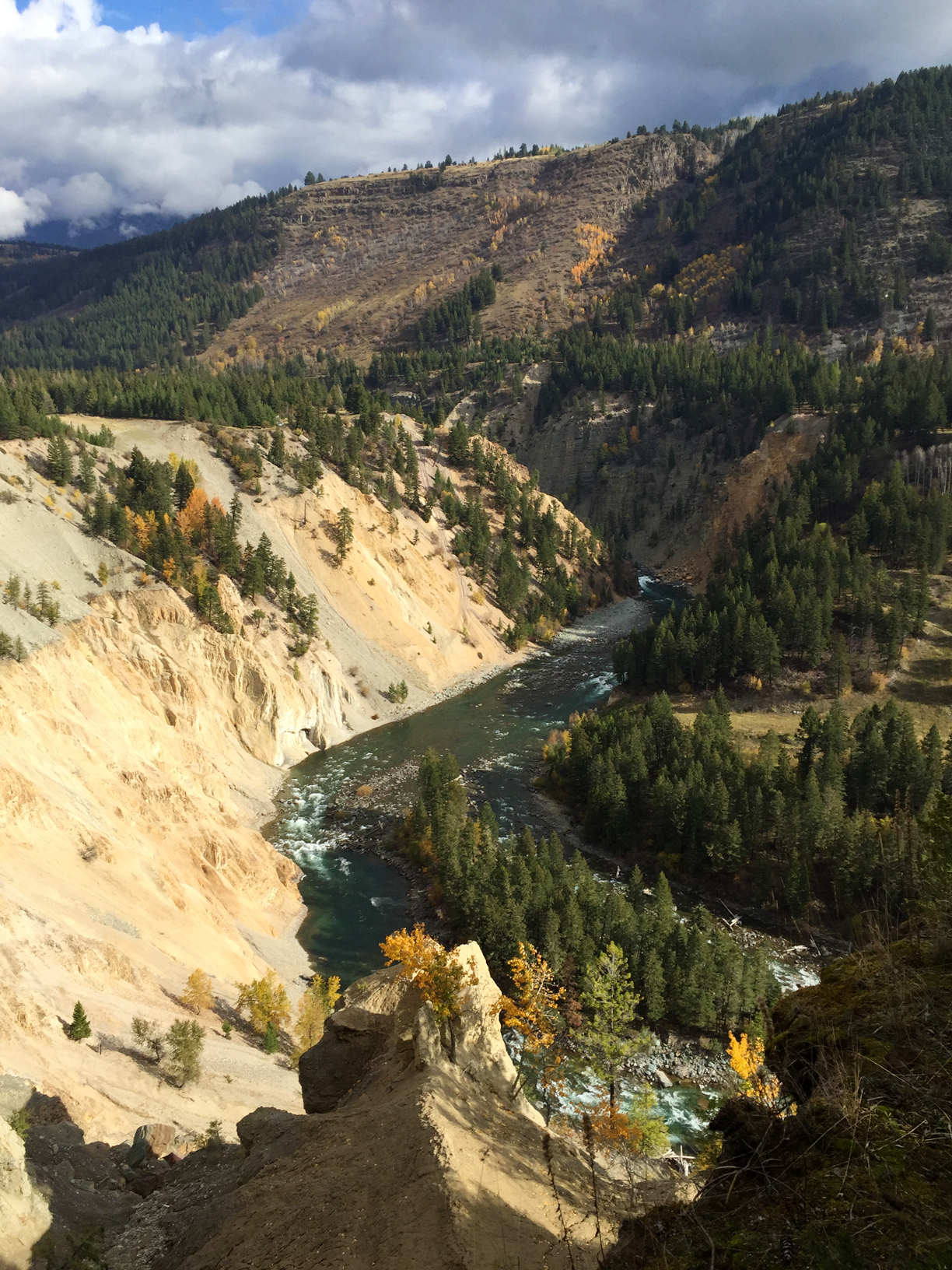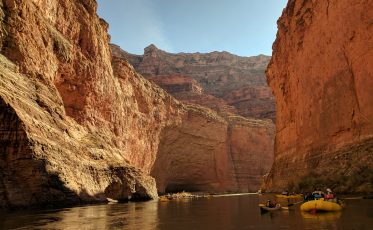B.C. on the Fly
I glanced down at my notebook as I perused the only store resembling a fly shop in Hope, British Columbia. Assuming it would be simple to find a local outfitter next to one of B.C.’s premier fisheries, I had saved my shopping for across the border. Copper Coachmen. Doc Spratley. Alexandra. Muddler. Royal Coachmen. Seems they had what I was looking for, but I couldn’t decide whether the bugs scattered throughout the wood boxes were the product of a hasty tying session or an overseas factory, the two not being mutually exclusive. Whatever the case, it was a fleeting thought. I was about to explore so many creeks, rivers, and streams it didn’t matter. I decided to adopt the Tenkara approach: it’s not about the type of imitation, it’s about what you do with it.
 Gold panner on the Fraser River
Gold panner on the Fraser River
Emory Creek & Fraser River
My first cast was where the sparkle of Emory Creek met the chocolatey, green mass of the Fraser River – the perfect place for a big, hungry trout to linger. The creeping cliffsides and massive conifers stole my focus as I idly cast into the confluence. I began working my way upstream and houses soon began to stipple the creek side. Thankfully, most turned out to be abandoned or in disrepair. I was trying to coax a little cutthroat out from behind a rock when a massive hound came bounding into the water. Flush, I scrambled atop a nearby rock, hoping the dog wouldn’t dare swim the rest of the way or that a watchful owner was nearby. Sure enough, a smoky voice rang into earshot and the barking ceased. Bill introduced himself as soon as I set foot on the bank. He was an incredibly nice guy with some interesting views on the government and land ownership. Bill told me where the birds fished, about the First Nations woman who would pass by carrying fish bigger than her children, how the salmon would be spawning at our feet in a few weeks, and about a deep pool and waterfall about four clicks up. After patiently nodding through Bill’s oration, I proceeded to make the journey up creek. Lots of fish but nothing worth putting in the frying pan. Molson, olives, cheese, and bread were going to have to make due.
Thompson & Nicola Rivers
I left the rain shadow of the Cascades early to fish my way north. There are so many phenomenal watersheds that flow into the Fraser, that I let the road choose where I would end up. As the Thompson came into view, I pulled over. The wide green water was just the change of pace I needed from the mighty Fraser, which has more water pumping through it than the Grand Canyon. (If you want to see what Niagara Falls would look like squeezed through a 35 meter [115 foot] slot, stop off at Hell’s Gate.) The rainbows and cutthroats were fast, skittish, and not as hungry as I had hoped, so I followed the Thompson to the Nicola.
Two dirt ruts heading towards the river and the absence of a “No Trespassing” sign were all I needed to make a maybe-too-quick-for-a-rental-car turn. I knew I’d found the hole when a fish the size of my thigh casually slashed through the shallow water. Beautiful green backs only meant one thing: steelhead. Catching steelies is no easy task, especially on a nimble, relatively fragile trout rod, but Orvis has a lifetime guarantee, so I really had nothing to lose. As I imagined walking away with some splintered carbon fiber and a backing-less reel, I tied on the largest streamer I could find and made peace with my impending sacrifice. Fortunately for me and the Orvis customer service department, I couldn’t get a hit. I threw every fly in my box at them but they didn’t seem interested. I could almost hear them smirking as they ripped by my feet. Accepting defeat, I made a mental note and vowed to bring my Washington steelhead mentor Paul back for another run at it.
Eagle River
Within two minutes of reaching the banks of the Eagle River, I found out this was an eponymous river. I was rigging up to fish an obscenely calm and picturesque run, when a bald eagle casually dipped its claws and came out with, what I was hoping would be, my breakfast. Now, I’m not going to say the eagle sent all the fish into hiding, but I couldn’t seem to get a bite all morning. Even for a few empty casts, it was well worth the trip. Fall colors draped the hillsides and the high elevation backdrop provided just enough reverence to make you feel “out there.” Summer on the Eagle is supposed to be phenomenal but either I was too late, or the birds beat me to it; not going to say which.
Elk River
“Are you going to be able to cast that thing?” I asked Saul. He was busy tying on an extravagantly large, furry streamer that looked like a small rabbit on a hook. Saul smiled and explained the mentality of a bull trout: “Bulls like ‘em big. They’re territorial fish.” At that moment I realized I didn’t know what I was getting into. I had heard stories of fighting a decent size cutthroat one minute and then the next minute have a 30+ inch bull trout on the line that just swallowed the fish you were trying to land. I couldn’t tell what was more awe-inspiring: the massive fish lurking next to me or the humbling scenery that seemed endlessly stunning and remote.
The Elk River is no secret. In Canadian terms, the water is “classified,” meaning you need a special license on top of the regular license for every day you fish the Elk and the river can easily sell out because there is a daily cap on classified licenses. It is a world-class destination with world-class regulations, but when you have a chance to fight monster bull trout, you don’t argue – you pay the fees, fill your backpack, and start hiking.
I met Saul the previous evening in Fernie playing music for small off-season crowd. He was an electrician on the nearby mining rig with a brown trout ornately inked down his right forearm. The conversation quickly meandered to fishing and we made plans to meet the following morning. We had gotten a tip from the local fly shop and spent a good chunk of the morning trekking down an almost sheer cliffside to the canyon bottom on a trail that would deter all but the most adventurous fisherman. Frigid water swept through the canyon like glass occasionally reflecting the glowing fall larches and snow-capped peaks behind us.
Saul was the first to break the icy calm and wade towards a large boulder that was home to more than a few fish. I wandered down river, tossing a hopper into riffles and sneaking into a couple fruitful pockets of water. Saul netted two huge bulls and then let me borrow his streamer rig for a few casts. I cast out into the middle of the river to swing my line behind a large boulder. A few quick strips and I was into a rather large cutthroat – the largest I’d seen this trip by far. But as vigorously as he snapped up fly, he shook free of the hook. Strip in. Cast. Same spot. Again, my line snapped taut and I jerked my rod to the sky. As I stripped in from the depths, I caught a glimpse of a bull trout’s creamy pink belly and was stunned by the size. An adrenaline-filled moment of complacency was just enough to unbend my rod and I never saw that bull again. The gray above swelled and we were engulfed in the sweet fragrance of Rocky Mountain rain. I’d forgotten a raincoat, but I hardly noticed as we scrambled out of the steep ravine; I was still in awe of the Elk River’s majesty.
I crossed the border that evening and was given a stern lecture about the produce I had forgotten to mention in my backpack. As I “yes sir”-ed and “no sir”-ed my way through the follow-up questions, I could only think about how I had just driven 2,500 miles, fished my way across Canada’s 5th largest province for two weeks, and barely covered a mile of it. British Columbia is carved up by more than 12,000 square miles of freshwater with fish in nearly every lake, river, stream, and creek. It’s beautiful. It’s magical. And it’s a place I will explore for the rest of my life.






